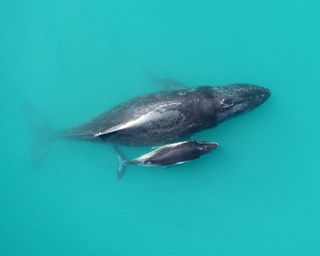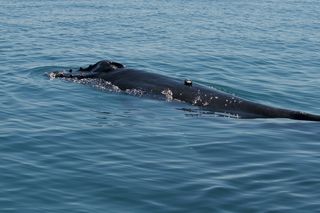'Whispering' Whales: Humpback Calves Speak Softly to Mom
Using temporary tags that recorded audio from humpback mothers and calves, scientists found that the calves communicated with their mothers very quietly — in muted squeaks compared to the bellows of adult males — perhaps to lower the risk of being overheard and pursued by killer whales, according to a new study.
These recordings show aspects of early life behavior in humpbacks for the first time, the researchers said. The findings offer a rare glimpse into the development of young humpbacks and hint at the complex interactions the young whales share with their mothers in order to survive during long migrations in the open ocean when they are still young and vulnerable, the study authors wrote.
Newborn whales face challenges unique to ocean-dwelling mammals: They must learn to nurse under their own power and coordinate that with swimming and holding their breath, the researchers said. And these young whales have only a few months of growth before the herd begins its seasonal migration from breeding grounds to feeding grounds, traveling as far as 5,000 miles (over 8,000 kilometers), the researchers explained in the study.

To better understand calves' behavior during migrations, researchers attached multisensor suction tags to eight humpback calves and two mothers in Exmouth Gulf in Western Australia, a known breeding and resting ground for humpbacks on their way to feeding areas in southern latitudes. The researchers placed the tags between the blowhole and dorsal fin on each whale, and programmed the tags to release automatically after 22 hours.
Speak low
Data gathered by the tags told scientists when the mothers and calves were diving and how they were moving during the dives, indicating when the calves might be nursing. Audio communications — "grunting" and "tonal sounds" — were also captured.
The scientists found that most of the vocalizations took place during dives, rather than when the calf and mother were resting close to the surface. And the sounds the calves made were extremely quiet, the researchers said, about 40 decibels lower than calls produced by singing whales, and up to 70 decibels lower than other social sounds from adults.

Visibility in Exmouth Gulf waters is poor, which could explain why mothers and calves called to each other more frequently while diving, to keep from being separated, the study said. But the calls didn't seem to be nursing cues; nursing appeared to follow physical contact, possibly head bumps in the mother's mammary area, the researchers wrote in the study. It's more likely that calves and mothers use their voices to maintain contact, and the quiet calls kept them from being "overheard" by opportunistic predators or interested male humpbacks, said the study's lead author, Simone Videsen, a researcher with the Department of Bioscience at the Aarhus University in Denmark.
Sign up for the Live Science daily newsletter now
Get the world’s most fascinating discoveries delivered straight to your inbox.
"By calling softly to its mother, the calf is less likely to be heard by killer whales, and [can] avoid attracting male humpbacks who want to mate with the nursing females," Videsen said in a statement.
"This migration is very demanding for young calves," Videsen added. "Knowing more about their suckling will help us understand what could disrupt this critical behavior, so we can target conservation efforts more effectively."
The findings were published online April 25 in the journal Functional Ecology.
Original article on Live Science.

Mindy Weisberger is an editor at Scholastic and a former Live Science channel editor and senior writer. She has reported on general science, covering climate change, paleontology, biology and space. Mindy studied film at Columbia University; prior to Live Science she produced, wrote and directed media for the American Museum of Natural History in New York City. Her videos about dinosaurs, astrophysics, biodiversity and evolution appear in museums and science centers worldwide, earning awards such as the CINE Golden Eagle and the Communicator Award of Excellence. Her writing has also appeared in Scientific American, The Washington Post and How It Works Magazine. Her book "Rise of the Zombie Bugs: The Surprising Science of Parasitic Mind Control" will be published in spring 2025 by Johns Hopkins University Press.
